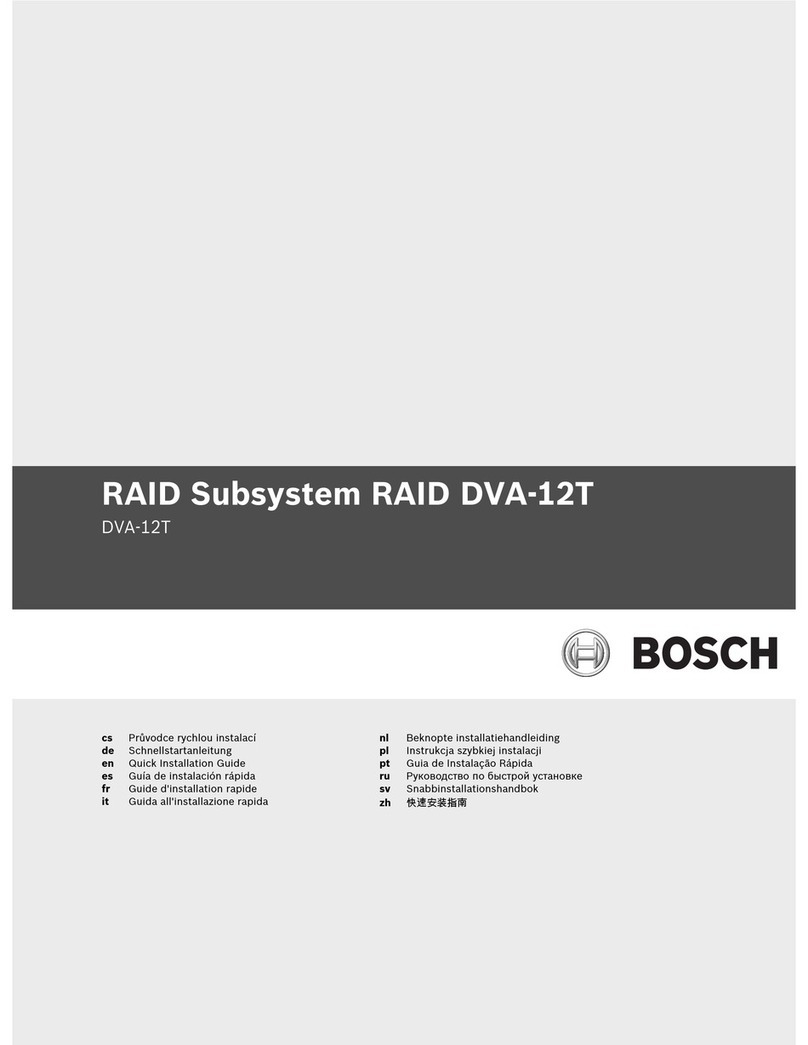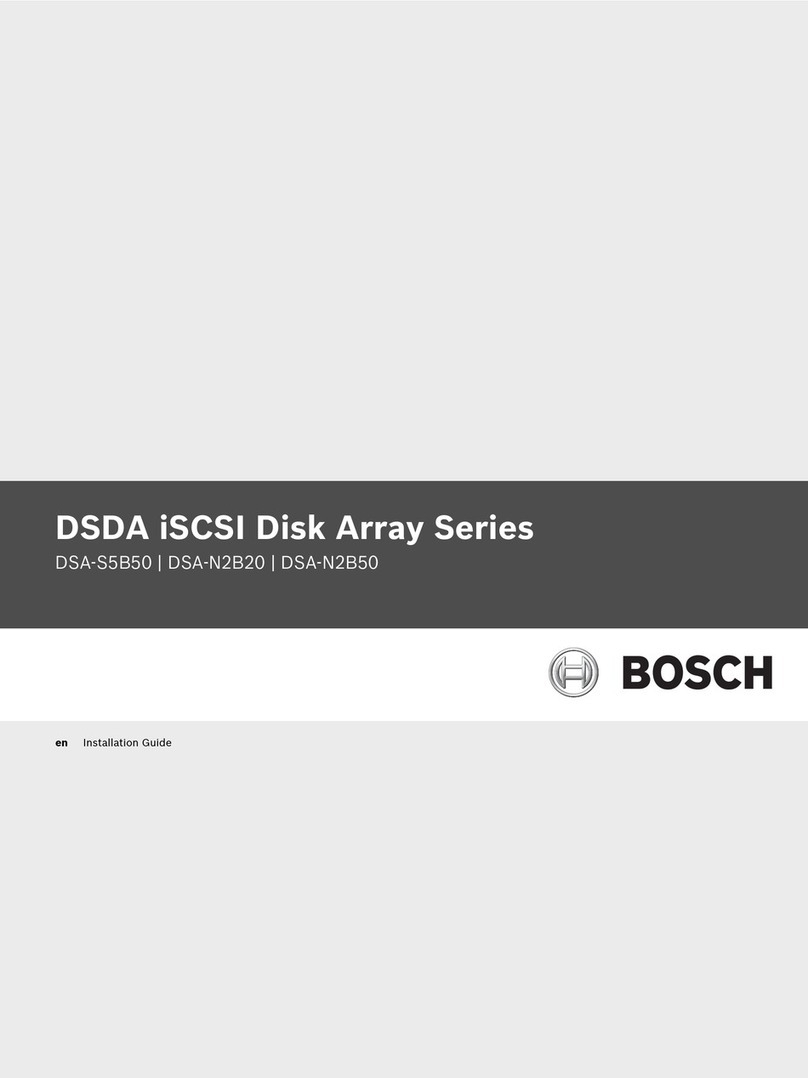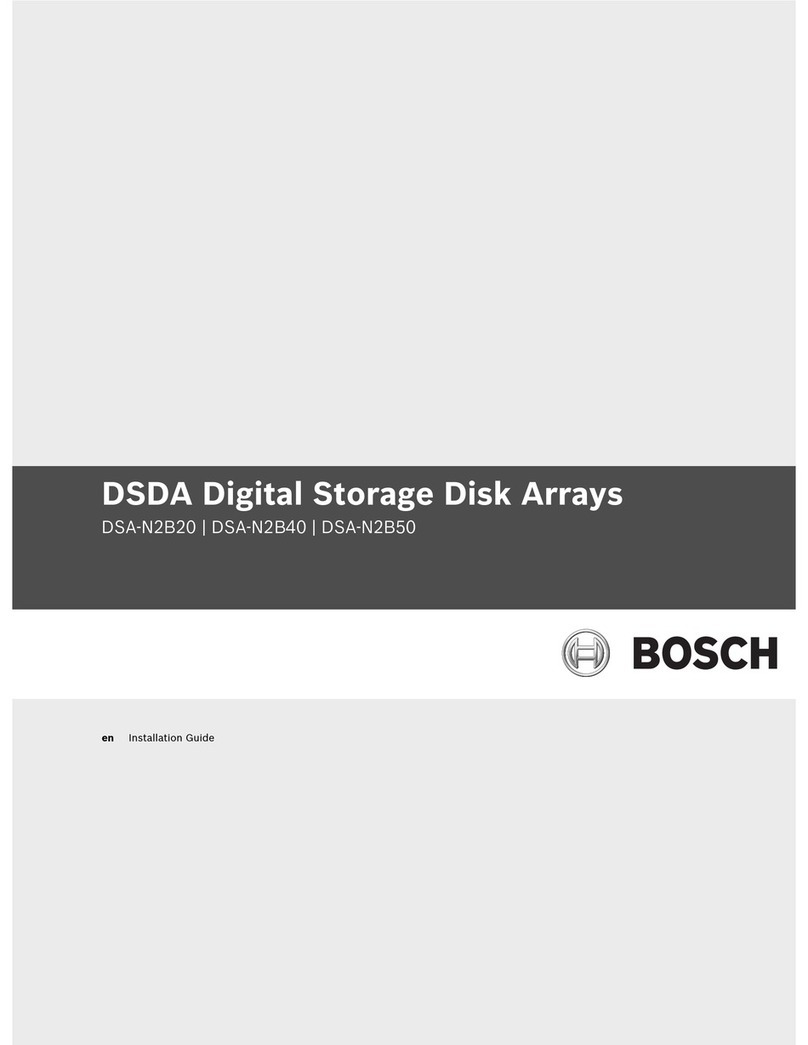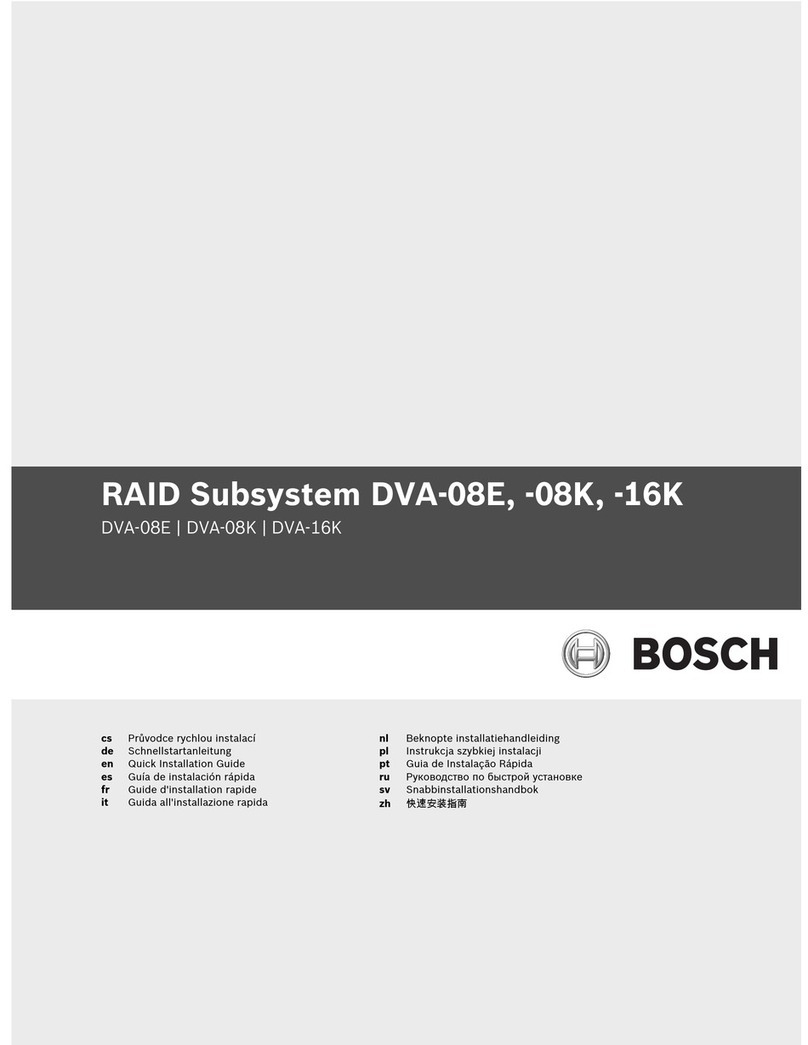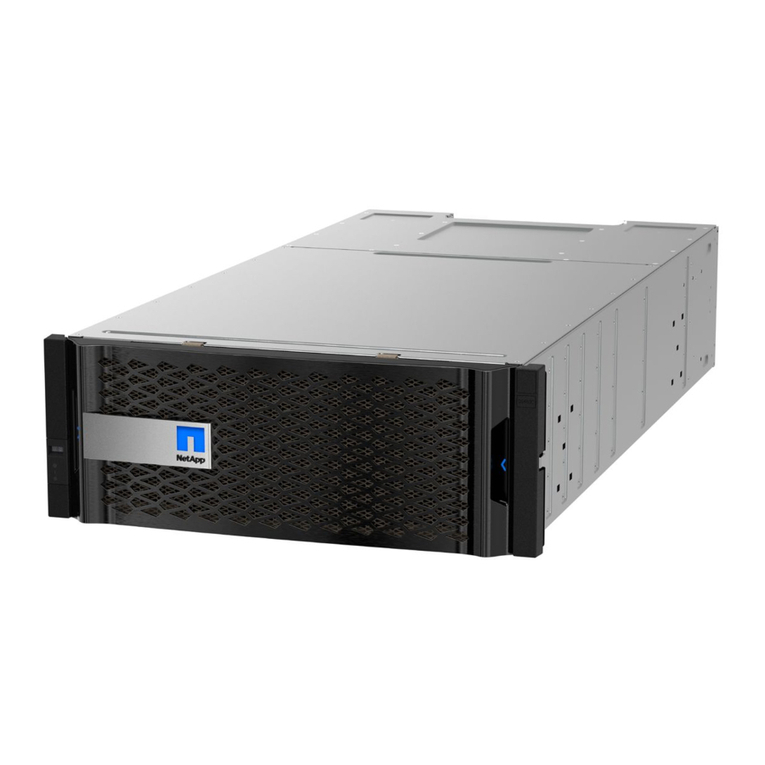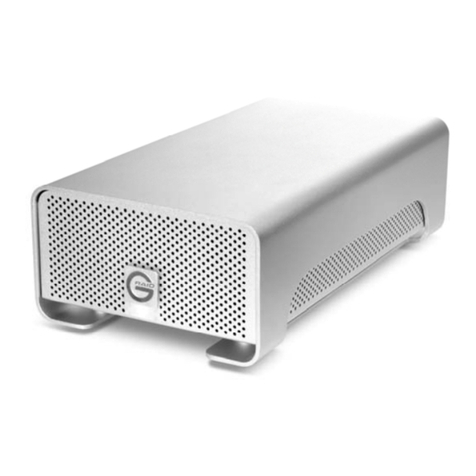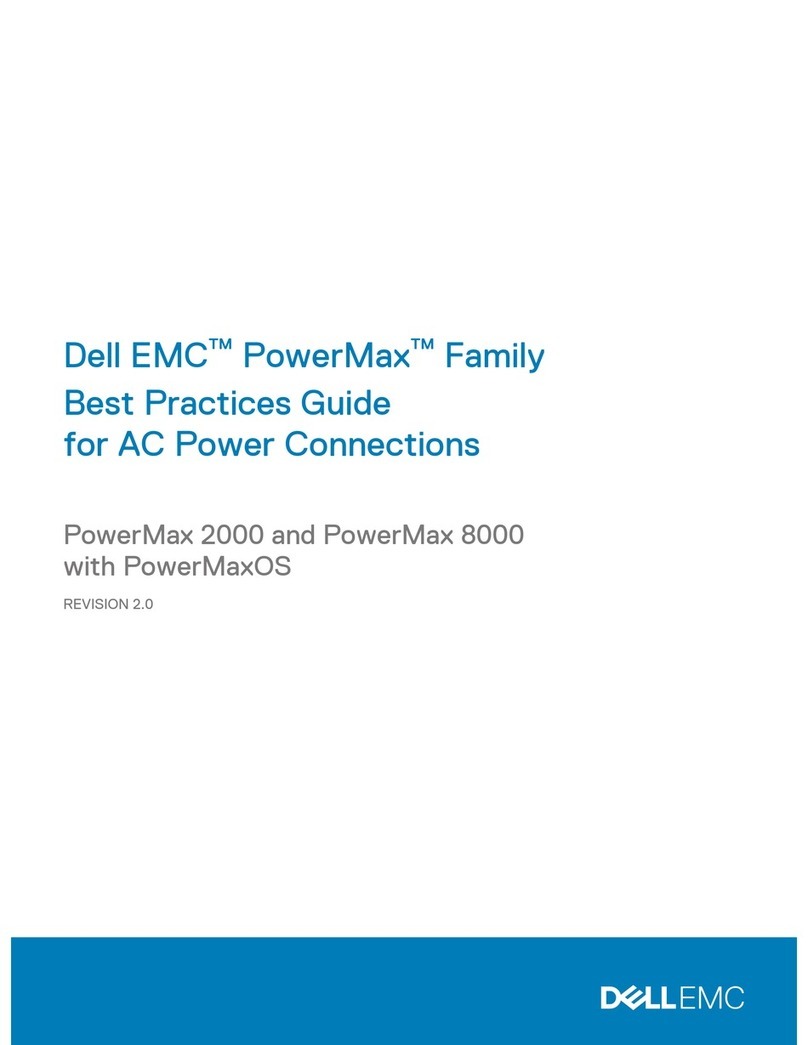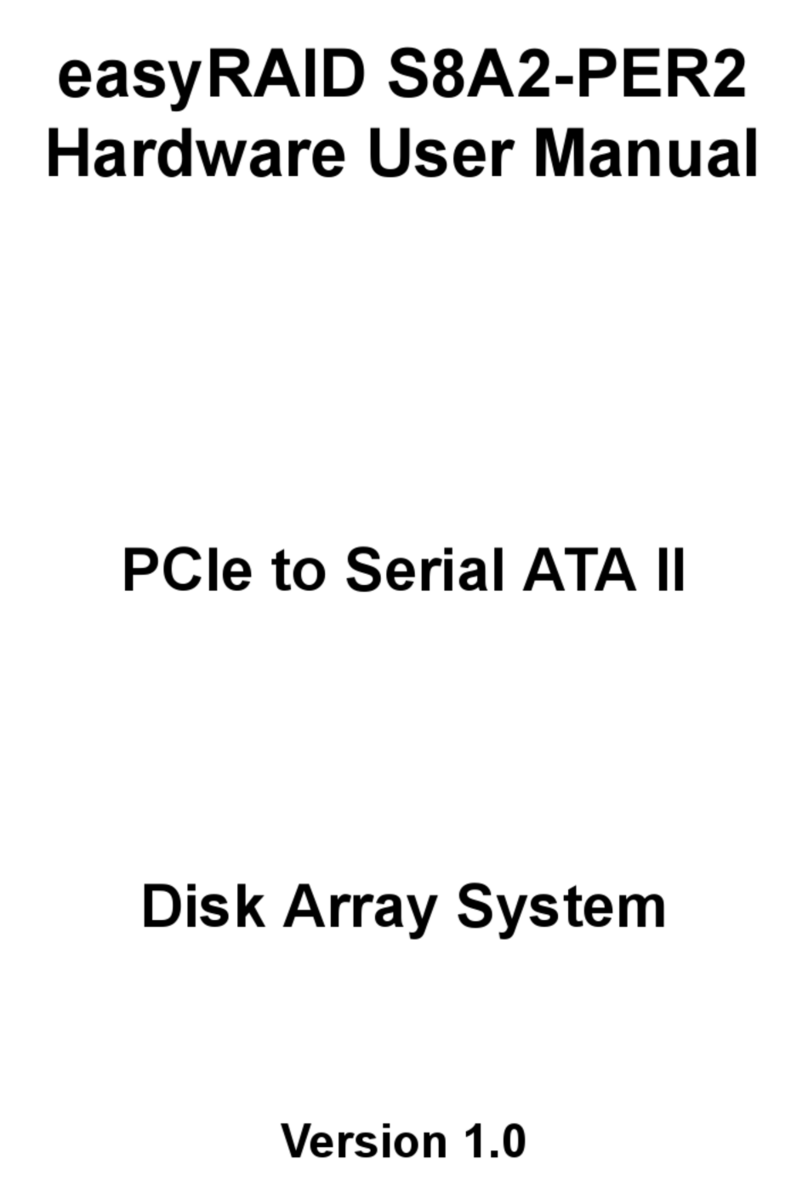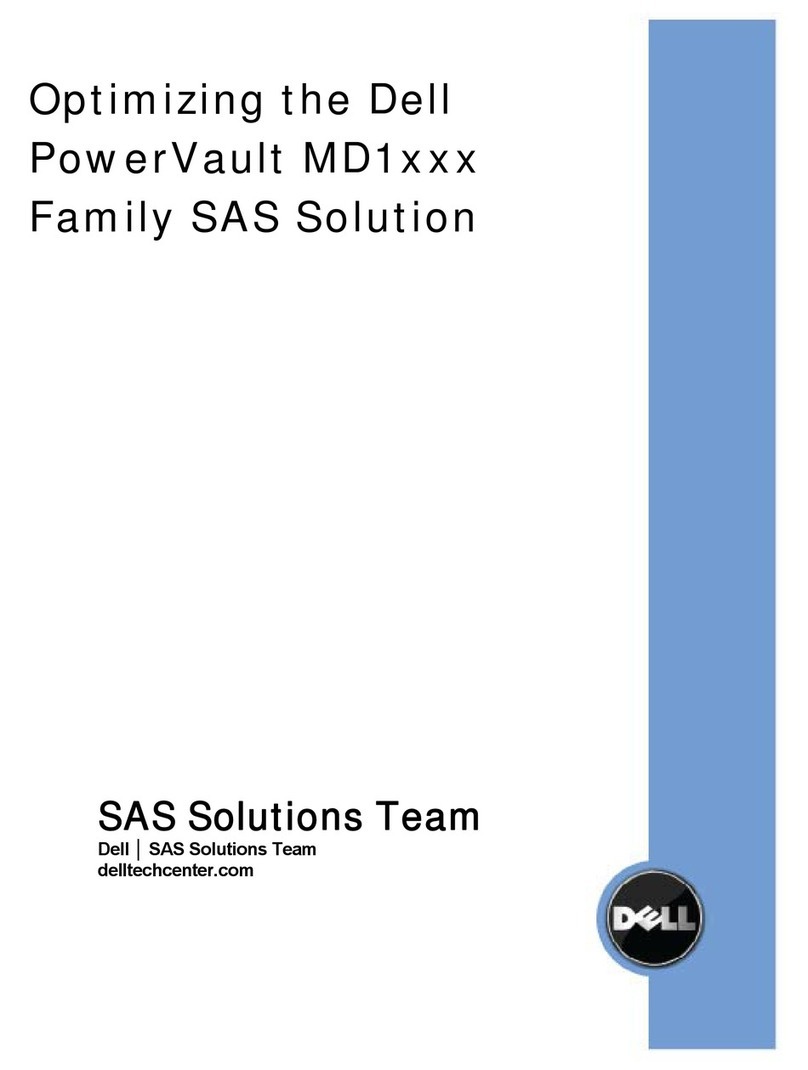Bosch DVA-16K SCSI User manual

RAID Subsystem DVA-16K
DVA-16K SCSI Premium Series
en Installation Manual


RAID Subsystem DVA-16K | Installation Manual Table of Contents | en 3
Bosch Security System F.01U.027.799 | V2 | 2008.08
Table of Contents
1 Warnings and Certifications . . . . . . . . . . . . . . . . . . . . . . . . . . . . . . . . . . . . . . . . . . . . . . . . . . . . . . . . . . 6
1.1 Warning . . . . . . . . . . . . . . . . . . . . . . . . . . . . . . . . . . . . . . . . . . . . . . . . . . . . . . . . . . . . . . . . . . . . . . . . . . 6
1.2 Safety Precautions . . . . . . . . . . . . . . . . . . . . . . . . . . . . . . . . . . . . . . . . . . . . . . . . . . . . . . . . . . . . . . . . . 6
1.3 Certifications. . . . . . . . . . . . . . . . . . . . . . . . . . . . . . . . . . . . . . . . . . . . . . . . . . . . . . . . . . . . . . . . . . . . . . 7
2 Introduction. . . . . . . . . . . . . . . . . . . . . . . . . . . . . . . . . . . . . . . . . . . . . . . . . . . . . . . . . . . . . . . . . . . . . . . 8
2.1 Product Overview . . . . . . . . . . . . . . . . . . . . . . . . . . . . . . . . . . . . . . . . . . . . . . . . . . . . . . . . . . . . . . . . . . 8
2.2 Management . . . . . . . . . . . . . . . . . . . . . . . . . . . . . . . . . . . . . . . . . . . . . . . . . . . . . . . . . . . . . . . . . . . . . . 9
2.3 Best Practices . . . . . . . . . . . . . . . . . . . . . . . . . . . . . . . . . . . . . . . . . . . . . . . . . . . . . . . . . . . . . . . . . . . . 10
2.3.1 Avoiding Points of Failure . . . . . . . . . . . . . . . . . . . . . . . . . . . . . . . . . . . . . . . . . . . . . . . . . . . . . . . . . . . 10
2.3.2 Dual-Redundant Data Paths . . . . . . . . . . . . . . . . . . . . . . . . . . . . . . . . . . . . . . . . . . . . . . . . . . . . . . . . . 10
2.3.3 ID Mapping . . . . . . . . . . . . . . . . . . . . . . . . . . . . . . . . . . . . . . . . . . . . . . . . . . . . . . . . . . . . . . . . . . . . . . 10
2.4 Enclosure Chassis . . . . . . . . . . . . . . . . . . . . . . . . . . . . . . . . . . . . . . . . . . . . . . . . . . . . . . . . . . . . . . . . . 10
2.4.1 Chassis Overview . . . . . . . . . . . . . . . . . . . . . . . . . . . . . . . . . . . . . . . . . . . . . . . . . . . . . . . . . . . . . . . . . 10
2.4.2 Physical Dimensions . . . . . . . . . . . . . . . . . . . . . . . . . . . . . . . . . . . . . . . . . . . . . . . . . . . . . . . . . . . . . . . 11
2.4.3 Front Panel Overview . . . . . . . . . . . . . . . . . . . . . . . . . . . . . . . . . . . . . . . . . . . . . . . . . . . . . . . . . . . . . . 11
2.4.4 Hard Drive Numbering . . . . . . . . . . . . . . . . . . . . . . . . . . . . . . . . . . . . . . . . . . . . . . . . . . . . . . . . . . . . . . 12
2.4.5 Rear Panel Overview . . . . . . . . . . . . . . . . . . . . . . . . . . . . . . . . . . . . . . . . . . . . . . . . . . . . . . . . . . . . . . . 12
2.4.6 Backplane Board . . . . . . . . . . . . . . . . . . . . . . . . . . . . . . . . . . . . . . . . . . . . . . . . . . . . . . . . . . . . . . . . . . 12
2.5 Subsystem Components . . . . . . . . . . . . . . . . . . . . . . . . . . . . . . . . . . . . . . . . . . . . . . . . . . . . . . . . . . . . 13
2.5.1 LCD Panel . . . . . . . . . . . . . . . . . . . . . . . . . . . . . . . . . . . . . . . . . . . . . . . . . . . . . . . . . . . . . . . . . . . . . . . 13
2.5.2 Drive Trays. . . . . . . . . . . . . . . . . . . . . . . . . . . . . . . . . . . . . . . . . . . . . . . . . . . . . . . . . . . . . . . . . . . . . . . 13
2.5.3 The RAID Controller Module . . . . . . . . . . . . . . . . . . . . . . . . . . . . . . . . . . . . . . . . . . . . . . . . . . . . . . . . . 14
2.5.4 Controller Module Interfaces . . . . . . . . . . . . . . . . . . . . . . . . . . . . . . . . . . . . . . . . . . . . . . . . . . . . . . . . 14
2.5.5 DIMM Module . . . . . . . . . . . . . . . . . . . . . . . . . . . . . . . . . . . . . . . . . . . . . . . . . . . . . . . . . . . . . . . . . . . . 15
2.5.6 Battery Backup Unit (BBU) . . . . . . . . . . . . . . . . . . . . . . . . . . . . . . . . . . . . . . . . . . . . . . . . . . . . . . . . . . 15
2.5.7 Power Supply Units . . . . . . . . . . . . . . . . . . . . . . . . . . . . . . . . . . . . . . . . . . . . . . . . . . . . . . . . . . . . . . . . 15
2.5.8 Cooling Modules . . . . . . . . . . . . . . . . . . . . . . . . . . . . . . . . . . . . . . . . . . . . . . . . . . . . . . . . . . . . . . . . . . 16
2.6 Subsystem Monitoring. . . . . . . . . . . . . . . . . . . . . . . . . . . . . . . . . . . . . . . . . . . . . . . . . . . . . . . . . . . . . . 17
2.6.1 I2C bus . . . . . . . . . . . . . . . . . . . . . . . . . . . . . . . . . . . . . . . . . . . . . . . . . . . . . . . . . . . . . . . . . . . . . . . . . 17
2.6.2 LED Indicators. . . . . . . . . . . . . . . . . . . . . . . . . . . . . . . . . . . . . . . . . . . . . . . . . . . . . . . . . . . . . . . . . . . . 17
2.6.3 Firmware (FW) and Bosch RAIDWatch GUI . . . . . . . . . . . . . . . . . . . . . . . . . . . . . . . . . . . . . . . . . . . . . . 17
2.6.4 Audible Alarms . . . . . . . . . . . . . . . . . . . . . . . . . . . . . . . . . . . . . . . . . . . . . . . . . . . . . . . . . . . . . . . . . . . 17
2.7 Hot-swappable Components . . . . . . . . . . . . . . . . . . . . . . . . . . . . . . . . . . . . . . . . . . . . . . . . . . . . . . . . . 18
2.7.1 Hot-swap Capabilities . . . . . . . . . . . . . . . . . . . . . . . . . . . . . . . . . . . . . . . . . . . . . . . . . . . . . . . . . . . . . . 18
2.7.2 Components . . . . . . . . . . . . . . . . . . . . . . . . . . . . . . . . . . . . . . . . . . . . . . . . . . . . . . . . . . . . . . . . . . . . . 18
2.7.3 Normalized Airflow . . . . . . . . . . . . . . . . . . . . . . . . . . . . . . . . . . . . . . . . . . . . . . . . . . . . . . . . . . . . . . . . 18
3 Hardware Installation . . . . . . . . . . . . . . . . . . . . . . . . . . . . . . . . . . . . . . . . . . . . . . . . . . . . . . . . . . . . . . 19
3.1 Introduction. . . . . . . . . . . . . . . . . . . . . . . . . . . . . . . . . . . . . . . . . . . . . . . . . . . . . . . . . . . . . . . . . . . . . . 19
3.2 Installation Prerequisites . . . . . . . . . . . . . . . . . . . . . . . . . . . . . . . . . . . . . . . . . . . . . . . . . . . . . . . . . . . 19
3.3 Safety Precautions . . . . . . . . . . . . . . . . . . . . . . . . . . . . . . . . . . . . . . . . . . . . . . . . . . . . . . . . . . . . . . . . 20
3.3.1 Precautions and Instructions . . . . . . . . . . . . . . . . . . . . . . . . . . . . . . . . . . . . . . . . . . . . . . . . . . . . . . . . 20
3.3.2 Static-free Installation . . . . . . . . . . . . . . . . . . . . . . . . . . . . . . . . . . . . . . . . . . . . . . . . . . . . . . . . . . . . . . 20
3.4 General Installation Procedure . . . . . . . . . . . . . . . . . . . . . . . . . . . . . . . . . . . . . . . . . . . . . . . . . . . . . . . 21
3.4.1 Installation Procedure Flowchart . . . . . . . . . . . . . . . . . . . . . . . . . . . . . . . . . . . . . . . . . . . . . . . . . . . . . 21
3.5 Unpacking the Subsystem . . . . . . . . . . . . . . . . . . . . . . . . . . . . . . . . . . . . . . . . . . . . . . . . . . . . . . . . . . . 21
3.6 Rack/Cabinet Installation . . . . . . . . . . . . . . . . . . . . . . . . . . . . . . . . . . . . . . . . . . . . . . . . . . . . . . . . . . . 22
3.7 Drive Tray Installation . . . . . . . . . . . . . . . . . . . . . . . . . . . . . . . . . . . . . . . . . . . . . . . . . . . . . . . . . . . . . . 22

4en | Table of Contents RAID Subsystem DVA-16K | Installation Manual
F.01U.027.799 | V2 | 2008.08 Bosch Security System
4 Subsystem Monitoring . . . . . . . . . . . . . . . . . . . . . . . . . . . . . . . . . . . . . . . . . . . . . . . . . . . . . . . . . . . . . . 24
4.1 Subsystem Monitoring Overview . . . . . . . . . . . . . . . . . . . . . . . . . . . . . . . . . . . . . . . . . . . . . . . . . . . . . . 24
4.2 Status Indicating LEDs . . . . . . . . . . . . . . . . . . . . . . . . . . . . . . . . . . . . . . . . . . . . . . . . . . . . . . . . . . . . . . 25
4.2.1 Brief Overview of the LEDs . . . . . . . . . . . . . . . . . . . . . . . . . . . . . . . . . . . . . . . . . . . . . . . . . . . . . . . . . . 25
4.2.2 LCD Panel. . . . . . . . . . . . . . . . . . . . . . . . . . . . . . . . . . . . . . . . . . . . . . . . . . . . . . . . . . . . . . . . . . . . . . . . 25
4.2.3 Drive Tray LEDs . . . . . . . . . . . . . . . . . . . . . . . . . . . . . . . . . . . . . . . . . . . . . . . . . . . . . . . . . . . . . . . . . . . 27
4.2.4 Controller Module LEDs . . . . . . . . . . . . . . . . . . . . . . . . . . . . . . . . . . . . . . . . . . . . . . . . . . . . . . . . . . . . . 27
4.2.5 LAN Port LEDs . . . . . . . . . . . . . . . . . . . . . . . . . . . . . . . . . . . . . . . . . . . . . . . . . . . . . . . . . . . . . . . . . . . . 29
4.2.6 BBU Module LED . . . . . . . . . . . . . . . . . . . . . . . . . . . . . . . . . . . . . . . . . . . . . . . . . . . . . . . . . . . . . . . . . . 29
4.2.7 PSU LEDs . . . . . . . . . . . . . . . . . . . . . . . . . . . . . . . . . . . . . . . . . . . . . . . . . . . . . . . . . . . . . . . . . . . . . . . . 29
4.2.8 Cooling Module LEDs . . . . . . . . . . . . . . . . . . . . . . . . . . . . . . . . . . . . . . . . . . . . . . . . . . . . . . . . . . . . . . . 30
4.3 Audible Alarm . . . . . . . . . . . . . . . . . . . . . . . . . . . . . . . . . . . . . . . . . . . . . . . . . . . . . . . . . . . . . . . . . . . . . 31
4.3.1 Default Threshold Values . . . . . . . . . . . . . . . . . . . . . . . . . . . . . . . . . . . . . . . . . . . . . . . . . . . . . . . . . . . . 31
4.3.2 Failed Devices . . . . . . . . . . . . . . . . . . . . . . . . . . . . . . . . . . . . . . . . . . . . . . . . . . . . . . . . . . . . . . . . . . . . 31
4.4 Monitoring . . . . . . . . . . . . . . . . . . . . . . . . . . . . . . . . . . . . . . . . . . . . . . . . . . . . . . . . . . . . . . . . . . . . . . . 32
5 Subsystem Connection and Operation. . . . . . . . . . . . . . . . . . . . . . . . . . . . . . . . . . . . . . . . . . . . . . . . . . 33
5.1 SCSI Connection Overview . . . . . . . . . . . . . . . . . . . . . . . . . . . . . . . . . . . . . . . . . . . . . . . . . . . . . . . . . . 33
5.1.1 SCSI Cables . . . . . . . . . . . . . . . . . . . . . . . . . . . . . . . . . . . . . . . . . . . . . . . . . . . . . . . . . . . . . . . . . . . . . . 33
5.1.2 SCSI Port on the Controller Rear Panel . . . . . . . . . . . . . . . . . . . . . . . . . . . . . . . . . . . . . . . . . . . . . . . . . 33
5.1.3 SCSI Termination . . . . . . . . . . . . . . . . . . . . . . . . . . . . . . . . . . . . . . . . . . . . . . . . . . . . . . . . . . . . . . . . . . 34
5.2 Host Connection Topology . . . . . . . . . . . . . . . . . . . . . . . . . . . . . . . . . . . . . . . . . . . . . . . . . . . . . . . . . . 35
5.2.1 Single Host . . . . . . . . . . . . . . . . . . . . . . . . . . . . . . . . . . . . . . . . . . . . . . . . . . . . . . . . . . . . . . . . . . . . . . . 35
5.2.2 Dual Hosts . . . . . . . . . . . . . . . . . . . . . . . . . . . . . . . . . . . . . . . . . . . . . . . . . . . . . . . . . . . . . . . . . . . . . . . 36
5.3 Daisy Chain. . . . . . . . . . . . . . . . . . . . . . . . . . . . . . . . . . . . . . . . . . . . . . . . . . . . . . . . . . . . . . . . . . . . . . . 38
5.3.1 Daisy Chain Topology . . . . . . . . . . . . . . . . . . . . . . . . . . . . . . . . . . . . . . . . . . . . . . . . . . . . . . . . . . . . . . . 38
5.3.2 Daisy Chain Procedures . . . . . . . . . . . . . . . . . . . . . . . . . . . . . . . . . . . . . . . . . . . . . . . . . . . . . . . . . . . . . 38
5.4 Power On . . . . . . . . . . . . . . . . . . . . . . . . . . . . . . . . . . . . . . . . . . . . . . . . . . . . . . . . . . . . . . . . . . . . . . . . 39
5.4.1 Check List. . . . . . . . . . . . . . . . . . . . . . . . . . . . . . . . . . . . . . . . . . . . . . . . . . . . . . . . . . . . . . . . . . . . . . . . 39
5.4.2 Power On Procedure . . . . . . . . . . . . . . . . . . . . . . . . . . . . . . . . . . . . . . . . . . . . . . . . . . . . . . . . . . . . . . . 39
5.4.3 Power On Status Check . . . . . . . . . . . . . . . . . . . . . . . . . . . . . . . . . . . . . . . . . . . . . . . . . . . . . . . . . . . . . 40
5.4.4 LCD Screen . . . . . . . . . . . . . . . . . . . . . . . . . . . . . . . . . . . . . . . . . . . . . . . . . . . . . . . . . . . . . . . . . . . . . . 40
5.5 Power Off Procedure . . . . . . . . . . . . . . . . . . . . . . . . . . . . . . . . . . . . . . . . . . . . . . . . . . . . . . . . . . . . . . . 41
6 Subsystem Maintenance . . . . . . . . . . . . . . . . . . . . . . . . . . . . . . . . . . . . . . . . . . . . . . . . . . . . . . . . . . . . 42
6.1 Overview. . . . . . . . . . . . . . . . . . . . . . . . . . . . . . . . . . . . . . . . . . . . . . . . . . . . . . . . . . . . . . . . . . . . . . . . . 42
6.1.1 About Subsystem Maintenance . . . . . . . . . . . . . . . . . . . . . . . . . . . . . . . . . . . . . . . . . . . . . . . . . . . . . . . 42
6.1.2 General Notes on Component Replacement . . . . . . . . . . . . . . . . . . . . . . . . . . . . . . . . . . . . . . . . . . . . . 42
6.2 Replacing Controller Module Components . . . . . . . . . . . . . . . . . . . . . . . . . . . . . . . . . . . . . . . . . . . . . . 43
6.2.1 Controller Module Maintenance Overview . . . . . . . . . . . . . . . . . . . . . . . . . . . . . . . . . . . . . . . . . . . . . . . 43
6.2.2 Removing the Controller Module . . . . . . . . . . . . . . . . . . . . . . . . . . . . . . . . . . . . . . . . . . . . . . . . . . . . . . 43
6.2.3 Replacing the Controller Module . . . . . . . . . . . . . . . . . . . . . . . . . . . . . . . . . . . . . . . . . . . . . . . . . . . . . . 44
6.3 DIMM Module Replacement . . . . . . . . . . . . . . . . . . . . . . . . . . . . . . . . . . . . . . . . . . . . . . . . . . . . . . . . . . 46
6.3.1 DIMM Module Considerations . . . . . . . . . . . . . . . . . . . . . . . . . . . . . . . . . . . . . . . . . . . . . . . . . . . . . . . . 46
6.3.2 DIMM Module Replacement Procedure . . . . . . . . . . . . . . . . . . . . . . . . . . . . . . . . . . . . . . . . . . . . . . . . . 46
6.4 Replacing a Faulty BBU Module . . . . . . . . . . . . . . . . . . . . . . . . . . . . . . . . . . . . . . . . . . . . . . . . . . . . . . . 48
6.4.1 BBU Warnings and Precautions . . . . . . . . . . . . . . . . . . . . . . . . . . . . . . . . . . . . . . . . . . . . . . . . . . . . . . . 48
6.4.2 Procedure. . . . . . . . . . . . . . . . . . . . . . . . . . . . . . . . . . . . . . . . . . . . . . . . . . . . . . . . . . . . . . . . . . . . . . . . 48
6.5 Replacing a Faulty PSU Module . . . . . . . . . . . . . . . . . . . . . . . . . . . . . . . . . . . . . . . . . . . . . . . . . . . . . . . 50
6.5.1 PSU Module Overview . . . . . . . . . . . . . . . . . . . . . . . . . . . . . . . . . . . . . . . . . . . . . . . . . . . . . . . . . . . . . . 50
6.5.2 Replacing the PSU Module . . . . . . . . . . . . . . . . . . . . . . . . . . . . . . . . . . . . . . . . . . . . . . . . . . . . . . . . . . . 50
6.6 Cooling Module Maintenance . . . . . . . . . . . . . . . . . . . . . . . . . . . . . . . . . . . . . . . . . . . . . . . . . . . . . . . . . 53
6.6.1 Cooling Module Overview. . . . . . . . . . . . . . . . . . . . . . . . . . . . . . . . . . . . . . . . . . . . . . . . . . . . . . . . . . . . 53
6.6.2 Replacing a Cooling Module . . . . . . . . . . . . . . . . . . . . . . . . . . . . . . . . . . . . . . . . . . . . . . . . . . . . . . . . . . 53
6.7 Replacing a Failed Hard Drive . . . . . . . . . . . . . . . . . . . . . . . . . . . . . . . . . . . . . . . . . . . . . . . . . . . . . . . . 55
6.7.1 Hard Drive Maintenance Overview . . . . . . . . . . . . . . . . . . . . . . . . . . . . . . . . . . . . . . . . . . . . . . . . . . . . . 55
6.7.2 Replacing a Hard Drive . . . . . . . . . . . . . . . . . . . . . . . . . . . . . . . . . . . . . . . . . . . . . . . . . . . . . . . . . . . . . . 56

RAID Subsystem DVA-16K | Installation Manual Table of Contents | en 5
Bosch Security System F.01U.027.799 | V2 | 2008.08
7 Appendix: Specifications. . . . . . . . . . . . . . . . . . . . . . . . . . . . . . . . . . . . . . . . . . . . . . . . . . . . . . . . . . . . 58
7.1 Technical Specifications . . . . . . . . . . . . . . . . . . . . . . . . . . . . . . . . . . . . . . . . . . . . . . . . . . . . . . . . . . . . 58
7.2 Controller Specifications. . . . . . . . . . . . . . . . . . . . . . . . . . . . . . . . . . . . . . . . . . . . . . . . . . . . . . . . . . . . 60
7.3 Drive Tray Specifications. . . . . . . . . . . . . . . . . . . . . . . . . . . . . . . . . . . . . . . . . . . . . . . . . . . . . . . . . . . . 61
7.4 Power Supply Specifications. . . . . . . . . . . . . . . . . . . . . . . . . . . . . . . . . . . . . . . . . . . . . . . . . . . . . . . . . 61
7.5 Cooling Module Specifications . . . . . . . . . . . . . . . . . . . . . . . . . . . . . . . . . . . . . . . . . . . . . . . . . . . . . . . 62
7.6 RAID Management . . . . . . . . . . . . . . . . . . . . . . . . . . . . . . . . . . . . . . . . . . . . . . . . . . . . . . . . . . . . . . . . . 62
7.7 Fault Tolerance Management . . . . . . . . . . . . . . . . . . . . . . . . . . . . . . . . . . . . . . . . . . . . . . . . . . . . . . . . 63
8 Appendix: Spare Parts and Accessories . . . . . . . . . . . . . . . . . . . . . . . . . . . . . . . . . . . . . . . . . . . . . . . . 64
8.1 Spare Parts . . . . . . . . . . . . . . . . . . . . . . . . . . . . . . . . . . . . . . . . . . . . . . . . . . . . . . . . . . . . . . . . . . . . . . 64
8.2 Accessories . . . . . . . . . . . . . . . . . . . . . . . . . . . . . . . . . . . . . . . . . . . . . . . . . . . . . . . . . . . . . . . . . . . . . . 64
9 Appendix: Pin Outs . . . . . . . . . . . . . . . . . . . . . . . . . . . . . . . . . . . . . . . . . . . . . . . . . . . . . . . . . . . . . . . . 65
9.1 VHDCI SCSI Port Pin Outs. . . . . . . . . . . . . . . . . . . . . . . . . . . . . . . . . . . . . . . . . . . . . . . . . . . . . . . . . . . 65
9.2 DB9 Audio Jack Pin Outs . . . . . . . . . . . . . . . . . . . . . . . . . . . . . . . . . . . . . . . . . . . . . . . . . . . . . . . . . . . 66
9.3 DB9 Audio Jack UPS Cable Pin Outs. . . . . . . . . . . . . . . . . . . . . . . . . . . . . . . . . . . . . . . . . . . . . . . . . . . 67
9.4 Null Modem . . . . . . . . . . . . . . . . . . . . . . . . . . . . . . . . . . . . . . . . . . . . . . . . . . . . . . . . . . . . . . . . . . . . . . 67
9.5 Ethernet Port Pin Outs . . . . . . . . . . . . . . . . . . . . . . . . . . . . . . . . . . . . . . . . . . . . . . . . . . . . . . . . . . . . . 68
9.6 Main Power . . . . . . . . . . . . . . . . . . . . . . . . . . . . . . . . . . . . . . . . . . . . . . . . . . . . . . . . . . . . . . . . . . . . . . 68
10 Index . . . . . . . . . . . . . . . . . . . . . . . . . . . . . . . . . . . . . . . . . . . . . . . . . . . . . . . . . . . . . . . . . . . . . . . . . . . 69

6en | Warnings and Certifications RAID Subsystem DVA-16K | Installation Manual
F.01U.027.799 | V2 | 2008.08 Bosch Security System
1 Warnings and Certifications
1.1 Warning
•A shielded power cord is required in order to meet FCC emission limits and also to pre-
vent interference with nearby radio and television reception.
•Use only shielded cables to connect I/O devices to this equipment. You are cautioned
that changes or modifications not expressly approved by the party responsible for com-
pliance could void your authority to operate the equipment.
1.2 Safety Precautions
Precautions and Instructions
•Prior to powering on the subsystem, ensure that the correct power range is being used.
•The subsystem comes with 16 drive bays. Leaving any of these drive bays empty will
greatly affect the efficiency of the airflow within the enclosure, and will consequently
lead to the system overheating, which can cause irreparable damage.
•If a module fails, leave it in place until you have a replacement unit and you are ready to
replace it.
•Airflow Consideration: The subsystem requires an airflow clearance, especially at the
front and rear.
•Handle subsystem modules using the retention screws, eject levers, and the metal
frames/face plates. Avoid touching PCB boards and connector pins.
•To comply with safety, emission, or thermal requirements, none of the covers or replace-
able modules should be removed. Make sure that all enclosure modules and covers are
securely in place during operation.
•Be sure that the rack cabinet into which the subsystem chassis will be installed provides
sufficient ventilation channels and airflow circulation around the subsystem.
•Provide a soft, clean surface to place your subsystem on before working on it. Servicing
on a rough surface may damage the exterior of the chassis.
•If it is necessary to transport the subsystem, repackage all drives and replaceable mod-
ules separately.
•Dual redundant controller models come with two controller modules that must be
installed into the subsystem. Single controller modules come with a single controller
module and a metal sheet is placed over the lower controller bay at the rear of the sub-
system. Since single controller modules cannot be upgraded, this metal sheet should
NEVER be removed.
ESD Precautions
Observe all conventional anti-ESD methods while handling system modules. The use of a
grounded wrist strap and an anti-static work pad are recommended. Avoid dust and debris in
your work area.

RAID Subsystem DVA-16K | Installation Manual Warnings and Certifications | en 7
Bosch Security System F.01U.027.799 | V2 | 2008.08
1.3 Certifications
FCC (applies in the U.S. and Canada)
FCC Class B Radio Frequency Interference Statement
This equipment has been tested and found to comply with the limits for a Class B digital
device, pursuant to Part 15 of the FCC Rules (47 CFR, Part 2, Part 15 and CISPR PUB. 22
Class B). These limits are designed to provide reasonable protection against harmful interfer-
ence when the equipment is operated in a residential installation. This equipment generates,
uses, and can radiate radio frequency energy and, if not installed and used in accordance with
this user’s manual, may cause harmful interference to radio communications. However, there
is no guarantee that interference will not occur in a particular installation. If this equipment
does cause harmful interference to radio or television reception, which can be determined by
turning the equipment off and on, you are encouraged to try to correct the interference by one
or more of the following measures:
•Reorient or relocate the receiving antenna.
•Increase the separation between the equipment and receiver.
•Connect the equipment into an outlet on a circuit different from that to which the
receiver is connected.
•Consult the dealer or an experienced radio/TV technician for help.
This device complies with Part 15 of FCC Rules. Operation is subject to the following two con-
ditions: 1) this device may not cause harmful interference, and 2) this device must accept any
interference received, including interference that may cause undesired operation.
This device is in conformity with the EMC.
CB (Certified Worldwide)
This device meets the requirements of the CB standard for electrical equipment with regard to
establishing a satisfactory level of safety for persons using the device and for the area sur-
rounding the apparatus. This standard covers only safety aspects of the above apparatus; it
does not cover other matters, such as style or performance.

8en | Introduction RAID Subsystem DVA-16K | Installation Manual
F.01U.027.799 | V2 | 2008.08 Bosch Security System
2 Introduction
This manual covers the DVA-16K series of RAID subsystems.
The 3U profile, SCSI-320 to SATA-II, RAID subsystem is capable of a high-performance storage
operation that has been specifically designed to meet the rapidly changing demands and
needs of today’s storage networks. The RAID subsystem is rigorous and durable that can be
easily configured and operated.
Fully featured RAID redundancy provides advanced data protection and ensures that the com-
plete range of RAID levels 0, 1(0+1), 3, 5, 10, 30, 50 and JBOD are supported. Complete sys-
tem redundancy, through fully redundant data paths and hot-swappable devices ensures the
overall protection of data. A long list of sophisticated firmware functions (multi-subsystem
configuration, dedicated/ global hot-spares, battery protected disk cache, automatic back-
ground rebuild, online drive expansion, intelligent drive handling, media scan, task-scheduler,
remote and real-time subsystem monitoring, and more). Further the system guarantees the
overall availability of valuable data.
System integrators, using the RAID series, will be able to rapidly develop SCSI-320 solutions.
This will help save both development time and the associated R&D costs, providing a compet-
itive edge in the marketplace. For users, the modular nature of the series minimizes the total
management cost of building a large storage network with a RAID subsystem.
The enhanced 3U RAID storage subsystem chassis is a 3U metal chassis divided into front and
rear sections, which are respectively accessed through front and rear panels. Pre-drilled
mounting holes in the sides of the 3U RAID subsystem enclosure allow you to attach sepa-
rately purchased slide rails so that you can install the enclosure into a rack or cabinet. The
modular design of the active components facilitates their easy installation and removal. Hot-
swap mechanisms are incorporated to eliminate power surges and signal glitches that might
happen while removing or installing these modules.
2.1 Product Overview
This manual introduces the SCSI-320 to SATA-II RAID subsystem shown in Figure 2.1.
Fig. 2.1 RAID Subsystem
The RAID subsystem comes with two (2) 320MB/second SCSI (SCSI-320) host channels. This
high-density subsystem supports up to sixteen (16) hot swappable, SATA-II hard drives in a 3U
profile. The core of the subsystem is the RAID controller board with the ASIC266 and a pre-
installed 256MB DDR RAM DIMM module with support for capacities up to 1GB. The new
SCSI-320 host channel features packet protocol, and its reduction in command overhead pro-
vide increased speed without bandwidth issues.
The metal container in which the controller board is pre-installed is referred to as the “con-
troller module.” The controller module is comprised of a PCB board, a rear faceplate, and a
metal canister. The controller module is accessed through the rear of the RAID subsystem. A
battery backup unit (BBU) is installed in the upper left side of the controller module when
viewed from the rear of the subsystem. The BBU is also accessible and hot swappable through
the rear panel of the RAID subsystem.

RAID Subsystem DVA-16K | Installation Manual Introduction | en 9
Bosch Security System F.01U.027.799 | V2 | 2008.08
Two (2) dual-stacked VHDCI SCSI connectors connect the RAID controller to single or dual
hosts and cascade external devices. Two (2) hot-swappable cooling modules protect the sub-
system from overheating, and two (2) hot-swappable power supply unit (PSU) modules pro-
vide constant power to the subsystem. The modular nature of the subsystem and the easy
accessibility to all major components ensure the ease of the subsystem maintenance.
2.2 Management
The RAID subsystem can be managed using either the firmware or the Bosch RAIDWatch web-
based GUI. The firmware can be accessed by using either the LCD panel (see Figure 2.2)
located at the front of the subsystem or a terminal emulation program installed on an external
computer and connected to the COM1 on the controller module’s rear panel (see Figure 2.2)
with the provided serial cable.
Fig. 2.2 Controller Module Rear Panel
If web-based management is desired, connecting the subsystem to the world wide web
through the Ethernet port on the controller module’s rear panel, (See Figure 2.2) allows you to
manage the RAID subsystem by Bosch RAIDWatch management software.
i
NOTICE!
On receiving and unpacking your subsystem, please check the package contents against the
included Unpacking Checklist. If any modules are missing, please contact your subsystem ven-
dor immediately.

10 en | Introduction RAID Subsystem DVA-16K | Installation Manual
F.01U.027.799 | V2 | 2008.08 Bosch Security System
2.3 Best Practices
2.3.1 Avoiding Points of Failure
To achieve maximum uptime when connecting a RAID subsystem into a storage environment,
it is imperative that points-of-failure are avoided. The best way to avoid them is through the
use of redundant components. As stated above, the cooling modules and PSU modules on the
subsystem are fully redundant. Using dual-redundant data paths will further minimize the pos-
sibility of system downtime.
2.3.2 Dual-Redundant Data Paths
When connecting the RAID subsystem to a server, dual-redundant data paths are recom-
mended. If one (1) data path fails, a second data path can be used to transmit data. Dual-
redundant data paths are supported by both the host and drive channels.
2.3.3 ID Mapping
Host ID mapping is flexible, in the sense that the same array can be associated with different
host ID/LUNs, allowing the host clustering configurations. Drives on different channels can
then be grouped into an array, and the array has its unique volume size, stripe size, and opti-
mization mode. Arrays of different RAID levels can be striped together into logical volumes,
making management of huge volume size an easier task.
2.4 Enclosure Chassis
2.4.1 Chassis Overview
The RAID storage subsystem chassis is an enhanced 3U metal chassis divided into front and
rear sections, which are respectively accessed through front (see Figure 2.4) and rear (see
Figure 2.6) panels. Pre-drilled mounting holes in the sides of the 3U RAID subsystem enclosure
allow you to attach separately purchased slide rails so that you can install the enclosure into a
rack or cabinet.
i
NOTICE!
Components accessed through the front panel are referred to as “Front Panel Components”
and components accessed through the rear panel are referred to as “Rear Panel Compo-
nents.”

RAID Subsystem DVA-16K | Installation Manual Introduction | en 11
Bosch Security System F.01U.027.799 | V2 | 2008.08
Fig. 2.3 RAID subsystem Overview
2.4.2 Physical Dimensions
The RAID subsystem comes in an enhanced 3U chassis with the following dimensions:
•With handles: 482.6mm x 131mm x 504.3mm (width x height x depth)
•Without handles: 445mm x 130mm x 488.2mm (width x height x depth)
2.4.3 Front Panel Overview
The front section of the subsystem features a 4 x 4 layout for sixteen (16) 3.5-inch drives. The
two (2) handles on the front of the subsystem enable you to easily insert/extract the chassis
into/from a rack or cabinet. The LCD panel on the left handle provides an easy way for you to
monitor and configure your subsystem.
The front panel of the RAID subsystem described in this manual is shown in Figure 2.4. A
description of each front panel component is given below:
Fig. 2.4 RAID subsystem Front View
The front panel shown in Figure 2.4 accommodates the following components:
•Drive bays with drive tray canisters: The drive bays house the hard drives.
•Right handle and left handle with LCD panel: The subsystem has right and left handles for
easier rackmounting and handling. The LCD panel shows system information and can be
used to configure and monitor the RAID subsystem. (Please refer to Section 2.5.1 LCD
Panel)

12 en | Introduction RAID Subsystem DVA-16K | Installation Manual
F.01U.027.799 | V2 | 2008.08 Bosch Security System
2.4.4 Hard Drive Numbering
The front panel of the RAID subsystem enclosure houses sixteen (16) hard drives in a 4x4 con-
figuration as shown in Figure 2.5. When viewed from the front, the drive bays (slots) are num-
bered 1 to 16 from left to right, from top to bottom.
Fig. 2.5 Hard Drive Numbering
2.4.5 Rear Panel Overview
The rear section of RAID subsystem is accessed through the rear panel and is reserved for a
single RAID controller module, one (1) BBU, two (2) power supply units (PSUs) and two (2)
cooling modules.
The rear panel of the RAID subsystem described in this manual is shown in Figure 2.6. A
description of each rear panel component is given below:
Fig. 2.6 RAID subsystem Rear View
The rear panel shown in Figure 2.6 accommodates the following components:
•RAID controller module: A controller board and a DDR RAM DIMM module are housed in
the controller module to provide the system RAID functionalities. (See Section 2.5.3 The
RAID Controller Module)
•BBU: A BBU sustains cache memory during a power shortage to prevent data loss. (See
Section 2.5.6 Battery Backup Unit (BBU))
•PSUs: The hot-swappable PSUs provide power to the subsystem. A power switch is
located on the right of each PSU to turn the system on and off. (See Section 2.5.7 Power
Supply Units)
•Cooling modules: The redundant cooling modules ventilate the subsystem to reduce the
temperature within the subsystem. (See Section 2.5.8 Cooling Modules)
•Dummy plate: This device is a single controller subsystem. The only controller module is
installed in the upper controller bay. A dummy plate covers the lower controller bay at
the rear of the subsystem.
2.4.6 Backplane Board
Internal backplane boards separate the front and rear sections of the RAID subsystem. The
PCB board provide logic level signals and low voltage power paths. They contain no user-ser-
viceable components.

RAID Subsystem DVA-16K | Installation Manual Introduction | en 13
Bosch Security System F.01U.027.799 | V2 | 2008.08
2.5 Subsystem Components
The RAID subsystem houses many active components and most of them can be accessed
through either the front or rear panel. The modular design of the active components facilitates
their easy installation and removal. Hot-swap mechanisms are incorporated to eliminate
power surges and signal glitches that might occur while removing or installing these modules.
2.5.1 LCD Panel
Fig. 2.7 LCD Panel
The LCD panel shown in Figure 2.7 consists of a 16x2-character LCD screen with push buttons
and LED status indicators. The LCD front panel provides full access to all RAID configuration
settings and monitoring functions. After powering up the subsystem, the initial screen will
show the subsystem model name. A different name may be assigned for the system or differ-
ent arrays. This will enable easier identification in a topology with numerous arrays.
2.5.2 Drive Trays
Fig. 2.8 Drive Tray Front View
The RAID subsystem comes with sixteen (16) drive trays (See Figure 2.8) designed to accom-
modate separately purchased standard 1-inch pitch, 3.5-inch disk drives. The drive bays are
easily accessible from the front of the enclosure. Two (2) LEDs on the front of the tray indi-
cate the drive status. A key-lock on each drive tray secures the hard drive in place, while an
easily accessible button ensures fast and efficient drive hot-swapping.
CAUTION!
Be careful not to warp, twist, or contort the drive tray in any way (e.g., by dropping it or rest-
ing heavy objects on it). The drive tray has been customized to fit into the drive bays in the
RAID subsystem. If the drive bay superstructure is deformed or altered, the drive trays may
not fit into the drive bay.

14 en | Introduction RAID Subsystem DVA-16K | Installation Manual
F.01U.027.799 | V2 | 2008.08 Bosch Security System
2.5.3 The RAID Controller Module
The RAID controller module contains a main circuit board, a preinstalled 256MB capacity or
above DDR RAM DIMM module and the controller module interfaces. The controller module
contains no user-serviceable components. Except when installing/upgrading the cache mem-
ory inside, the controller module should never be removed or opened.
The heart of the RAID controller subsystem is the 320MB per second SCSI-to-SATA controller
board. The controller comes with two (2) pre-set SCSI-320 host channels, CH0 and CH1. The
subsystem connects to the host through a VHDCI SCSI input connector, while the output con-
nector is ready to connect external devices. (See Figure 2.9)
The docking connector at the rear of the controller board is used to connect the controller
module to the backplane board. A DDR RAM DIMM socket is strategically placed in an easily
accessible location on the controller board for easy insertion of the DDR RAM DIMM module.
2.5.4 Controller Module Interfaces
All external interfaces that connect to external devices are located on the controller module
rear panel shown in Figure 2.9. The interfaces are listed below.
Fig. 2.9 Controller Module Interfaces
•Host Ports: Two (2) SCSI-320 host channels (CH0 and CH1 in Figure 2.9) connect the
subsystem to the host through two (2) dual-stacked VHDCI SCSI connectors.
•Ethernet Ports: A single 10/100BaseT Ethernet port (located next to COM2) is used for
remote management through the network.
•COM ports: The controller module comes with two (2) COM ports. One port is used to
access the controller-embedded configuration utility through the network, and the other
connects to a UPS connection. .
•Levers: Two (2) levers located in the sides of the controller board rear panel provide easy
controller module installation and secure the controller module in place.
CAUTION!
Although the RAID controller can be removed, the only time you should touch the controller
itself is to install the memory modules. The RAID controller is built of sensitive components
and unnecessary tampering can damage the controller.

RAID Subsystem DVA-16K | Installation Manual Introduction | en 15
Bosch Security System F.01U.027.799 | V2 | 2008.08
2.5.5 DIMM Module
The controller module comes with a pre-installed 256MB capacity or above DDR RAM DIMM
module and can support capacities up to 1GB. The DIMM module is placed in an easily
accessed location on the controller board. However, when the DIMM module is being
changed, the controller module must be removed from the subsystem chassis.
2.5.6 Battery Backup Unit (BBU)
The Li-ION battery backup unit (BBU) (see Figure 2.11) sustains cache memory after a power
failure. It is installed on the upper left side of the controller module in the rear subsystem
chassis.
Fig. 2.10 BBU Module
In accordance with international transportation regulations, the BBU is only charged to
between 35% and 45% of its total capacity when shipped. Therefore, after powering on the
subsystem (see Section 5.4 Power On) the BBU must be charged to its full capacity. It normally
requires approximately twelve (12) hours for the battery to be fully charged. If the battery is
not fully charged after twelve (12) hours, there is a problem with the BBU and you should con-
tact your subsystem vendor immediately. While the battery is being charged, the LED on the
BBU rear panel and the fifth LED on the rear panel of the controller module will flash slowly.
(See Section 4.2.6 BBU Module LED for details on the LED indicators.) You can check the sta-
tus of the battery’s charge via Bosch RAIDWatch or the firmware.
2.5.7 Power Supply Units
The RAID subsystem is equipped with two (2) redundant, hot-swappable, 460W PSUs, which
are located at the rear of the enclosure. (See Figure 2.6) The PSU is permanently mounted
into a 2U (dual-level) bracket especially designed to house both the PSU and a cooling mod-
ule, which is mounted in the lower part of the 2U bracket. Hot-swapping the PSU requires the
removal of the cooling module.
As shown in Figure 2.11, each PSU comes with a single power socket for power cord plug-in,
and a power switch on the right to turn the subsystem on and off. Two (2) embedded cooling
fans provide sufficient airflow to keep the PSU cool. A single LED indicates the PSU status.
When any power supply failure occurs, such as over-voltage or fan failure, the LED shines red.
A handle at the back of the PSU has been especially designed to enable you to remove the
PSU from the subsystem while the subsystem is online. This should only be done if the PSU
has failed and needs to be replaced.
A retention screw at the top of the PSU module secures the PSU to the enclosure. To remove
the PSU, the retention screw must be removed first. When installing a new PSU module, make
sure that the retention screw has been firmly secured.

16 en | Introduction RAID Subsystem DVA-16K | Installation Manual
F.01U.027.799 | V2 | 2008.08 Bosch Security System
Fig. 2.11 PSU Module
For the PSU specifications, please refer to Section 7 Appendix: Specifications.
2.5.8 Cooling Modules
The RAID subsystem is equipped with two (2) 1U, dual-fan, redundant, hot-swappable cooling
modules. They are installed in the cooling module slots located in the lower section of the
PSU modules (see Figure 2.12.) The two (2) 9.7cm fans housed in each cooling module pro-
vide two (2) fan speeds. When the subsystem is running in normal ambient temperature, the
fans operate at the lower speed. When the temperature reaches the temperature threshold,
the fans automatically change to high speed to generate more cooling air from the front to the
rear of the subsystem to extract the heat generated by the hard drives.
Cooling module specifications are listed in Section 7 Appendix: Specifications.
Fig. 2.12 Cooling Module

RAID Subsystem DVA-16K | Installation Manual Introduction | en 17
Bosch Security System F.01U.027.799 | V2 | 2008.08
2.6 Subsystem Monitoring
The RAID subsystem comes with a number of different monitoring methods that provide you
with continual updates on the status of the system and individual components. The following
monitoring features are included in the subsystem.
2.6.1 I2C bus
The following elements are interfaced to the RAID controller over a non-user-serviceable I2C
bus:
•PSU modules
•Cooling modules
•Temperature sensors (for the temperature of the backplane board and controller board)
2.6.2 LED Indicators
The following active components come with LEDs to indicate the status of the individual com-
ponent:
•RAID controller (5 LEDs)
•LCD panel (3 LEDs)
•BBU (2 LEDs)
•Cooling modules (2 LEDs)
•PSU modules (1 LED)
•Drive trays (2 LEDs)
2.6.3 Firmware (FW) and Bosch RAIDWatch GUI
Firmware: The firmware is pre-installed software used to configure the subsystem. The latest
firmware functionalities include Task Scheduler, Intelligent Drive Handling, and Media Scan.
Media Scan handles low quality drives in both the degraded mode and during the rebuild pro-
cess. Maintenance tasks will then be performed on an entire array or specific hard drives. Var-
ious options are user-configurable such as priority, start time, and execution internals.
Bosch RAIDWatch: Bosch RAIDWatch is a premier web-based graphics user interface (GUI)
that can be installed on a remote computer and accessed via the web. The manager communi-
cates with the array via the connection of the existing host interface or Ethernet link to the
array’s LAN port.
2.6.4 Audible Alarms
The RAID subsystem comes with audible alarms that are triggered when certain active compo-
nents fail or when certain (controller or subsystem) thresholds are exceeded. Whenever you
hear an audible alarm from the RAID subsystem, it is imperative that you determine the cause
and rectify the problem immediately.
Event notification messages indicate the completion or status of array configuration tasks and
are always accompanied by two (2) or three (3) successive and prolonged beeps.
CAUTION!
Failing to respond when an audible alarm is heard can lead to permanent damage of the RAID
subsystem. When an audible alarm is heard, rectify the problem as soon as possible.

18 en | Introduction RAID Subsystem DVA-16K | Installation Manual
F.01U.027.799 | V2 | 2008.08 Bosch Security System
2.7 Hot-swappable Components
2.7.1 Hot-swap Capabilities
The RAID subsystem comes with a number of hot-swappable components. A hot-swap compo-
nent is one that can be exchanged while the subsystem is still online without affecting the
operational integrity of the subsystem. These components should only be removed from the
subsystem when they are being replaced. At no other time should these components be
removed from the subsystem.
2.7.2 Components
The following components are hot-swappable:
•Power supply units (PSUs)
•Cooling modules
•BBU
•Hard drives
2.7.3 Normalized Airflow
Proper subsystem cooling is referred to as “normalized” airflow. Normalized airflow ensures
the sufficient cooling of the subsystem and is only attained when all components are properly
installed. Therefore, a failed component should only be hot-swapped when a replacement is
available. If a failed component is removed but not replaced, permanent damage to the sub-
system can result.

RAID Subsystem DVA-16K | Installation Manual Hardware Installation | en 19
Bosch Security System F.01U.027.799 | V2 | 2008.08
3 Hardware Installation
3.1 Introduction
This chapter gives detailed instructions on how to install the subsystem. When installing the
subsystem, it is necessary to install the controller module, hard drives, and drive trays. Instal-
lation into a rack or cabinet should occur before the hard drives or drive trays are installed
into the subsystem. Please confirm that you received all of the components listed on the
Unpacking List that came with the subsystem before proceeding with the installation process.
3.2 Installation Prerequisites
1. Static-free installation environment: The RAID subsystem must be installed in a static-free
environment to minimize the possibility of electrostatic discharge (ESD) damage. (See
Section 3.3.2 Static-free Installation)
2. Component check: Before installing the RAID subsystem, you should first check to see
that you have received all the required components. (See Section 3.5 Unpacking the Sub-
system) If any items appear damaged, contact your vendor for a replacement.
3. Hard drives: Up to sixteen (16) SATA-I or SATA-II hard drives must be purchased sepa-
rately prior to the RAID subsystem installation.
4. Cabling: The RAID subsystem requires an external VHDCI to VHDCI SCSI round cable to
connect the subsystem to a host computer. Please see Section 5 Subsystem Connection
and Operation for sample topologies and configuration options.
5. Memory module: If you wish to change the pre-installed memory module, a separately
purchased module must be installed. (See Section 6.3 DIMM Module Replacement)
6. Rack installation: The enclosure chassis can be installed into rack cabinet using sepa-
rately purchased mounting rails, rear-attached brackets, or Bosch’s slide rails. (See
Section 3.6 Rack/Cabinet Installation)
CAUTION!
Please note that the installation instructions described in this manual should be carefully fol-
lowed to prevent any difficulties and damages to your system.

20 en | Hardware Installation RAID Subsystem DVA-16K | Installation Manual
F.01U.027.799 | V2 | 2008.08 Bosch Security System
3.3 Safety Precautions
3.3.1 Precautions and Instructions
1. Be sure the correct power range (100-120 or 200-230VAC) is supplied by your rack cabi-
net or power outlet.
2. Thermal notice: All drive trays (even if they do not contain a hard drive) must be installed
into the enclosure. Leaving a drive bay or module slot open will greatly affect the airflow
efficiency within the enclosure, and will consequently lead to system overheating. Keep a
faulty module in place until you have a replacement unit and you are ready to replace it.
3. An enclosure without disk drives can weigh over 24 kilograms. Two (2) people are
required to install or relocate the subsystem. Drives should be removed from the enclo-
sure before moving the subsystem.
4. Airflow considerations: The subsystem requires an airflow clearance especially on the
front and rear. For proper ventilation, a minimum of 2.5cm is required between the front
of the enclosure and rack cover; a minimum of 5cm is required between the enclosure
and end of the rack.
5. Handle the system modules by the retention screws, eject levers, or the module’s metal
frame/face plate only. Avoid touching the PCB boards and connector pins.
6. None of the covers or replaceable modules should be removed in order to maintain com-
pliance with safety, emission, or thermal requirements.
7. Always secure every enclosure module by its retaining screws or make sure it is held in
place by its latches.
8. Always make sure the subsystem has a safe electrical earth connection via power cords
or chassis ground by the rack cabinet.
9. Be sure that the rack cabinet in which the subsystem chassis is to be installed provides
sufficient ventilation channels and airflow circulation around the subsystem.
10. Provide a soft, clean surface to place your enclosure on before working on it. Servicing
the enclosure on a rough surface may damage the finish of the chassis.
11. If it is necessary to transport the subsystem, repackage all drives and replaceable mod-
ules separately.
3.3.2 Static-free Installation
Static electricity can damage the system’s electronic components. To prevent ESD damage to
any of the components, follow these precautions before touching or handling them:
•Discharge the static electricity accumulated in your body by wearing an anti-static wrist-
band.
•Avoid carpets, plastic, vinyl, and Styrofoam in your work area.
•Handle all components by holding their edges or metal frames. Avoid touching the
exposed circuitry on PCB boards and connector pins.
This manual suits for next models
1
Table of contents
Other Bosch Disk Array System manuals
Popular Disk Array System manuals by other brands
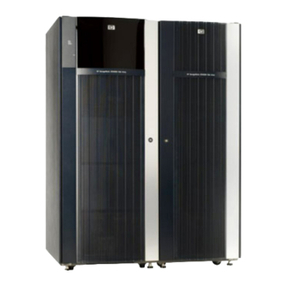
HP
HP STORAGEWORKS XP24000 user guide
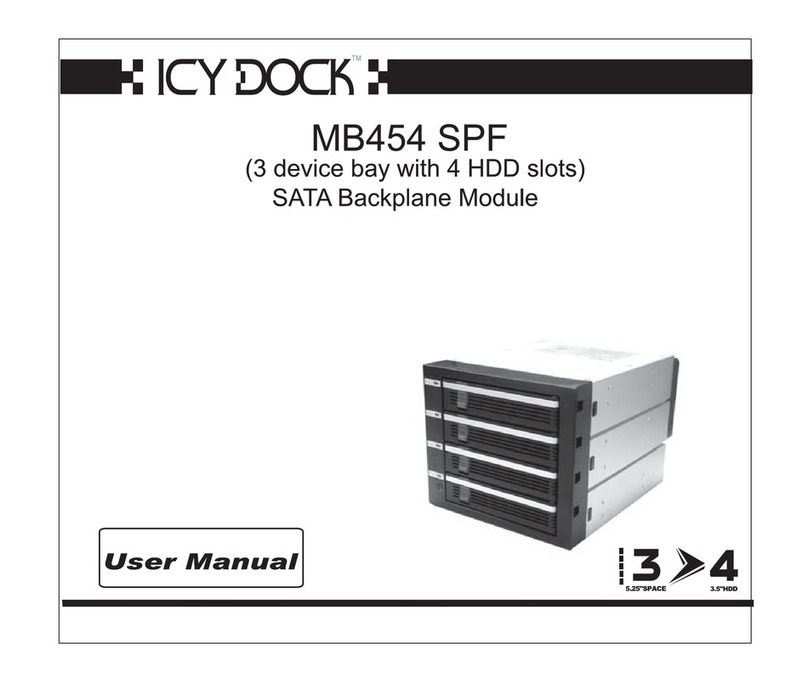
Icy Dock
Icy Dock SPFMB user manual
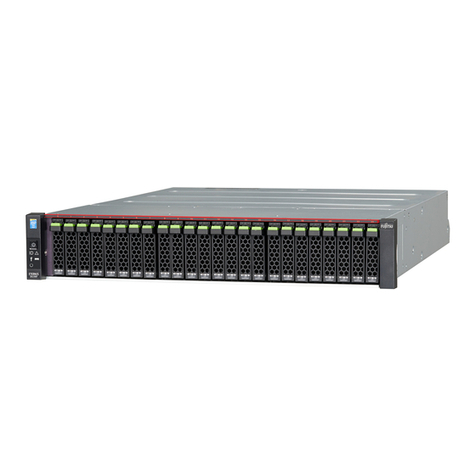
Fujitsu
Fujitsu Eternus DX200F Configuration guide
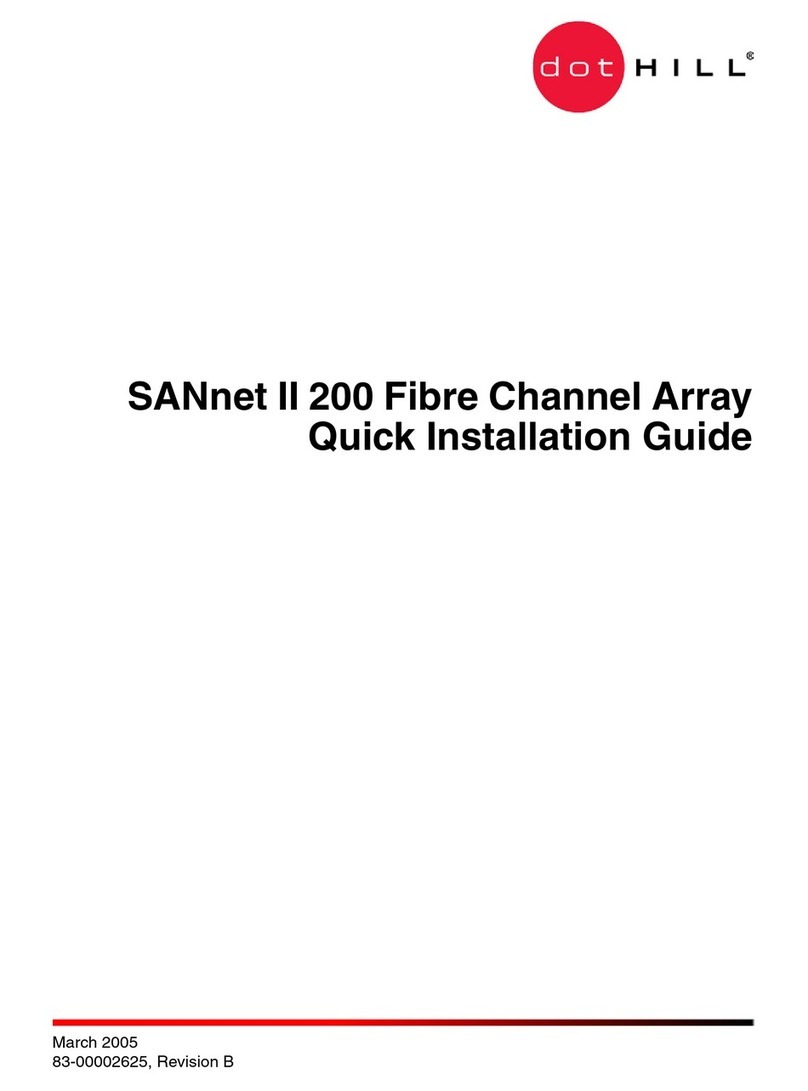
Dot Hill Systems
Dot Hill Systems SANnet II 200 Quick installation guide
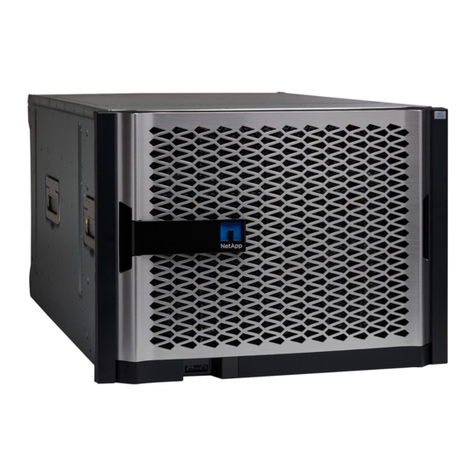
NetApp
NetApp AFF A700 Installation and setup instructions
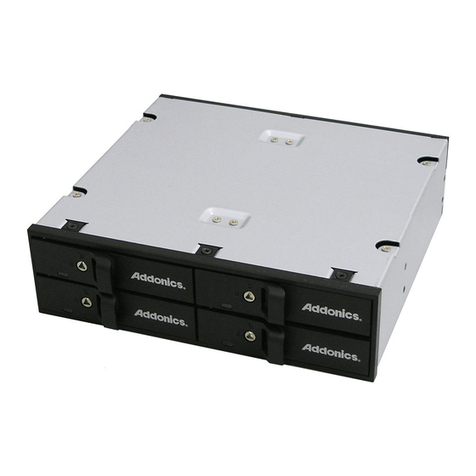
Addonics Technologies
Addonics Technologies AESN4DA25 user guide
